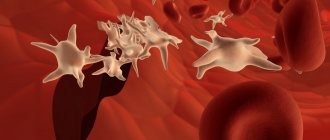Potassium is the main intracellular macronutrient. About 90% of all potassium ions in the body are located inside cells. Such a large difference between intra- and extracellular concentrations is necessary to maintain the membrane potential of cells, their ability to excite and transmit nerve impulses. Accurate data on the overall prevalence of hypokalemia are not available. It is only known that it is detected in 3-20% of patients undergoing hospital treatment. This disorder is somewhat more often observed in patients of cardiology and gastroenterology departments.
What is hypokalemia?
Hypokalemia is a metabolic imbalance characterized by extremely low levels of potassium in the blood. Hypokalemia is a symptom of another disease or condition, or a side effect of using diuretics. The body needs potassium for muscle contraction (including the heart) and for the functioning of many complex proteins (enzymes). Potassium is found primarily in skeletal muscle and bone and, along with sodium, is involved in the normal flow of body fluids between the body's cells. The normal concentration of potassium in the body is regulated by the kidneys through excretion in the urine.
When the kidneys are functioning normally, the amount of potassium in the diet is sufficient for the body to use, and excess is usually excreted in urine and sweat. Body chemicals and hormones such as aldosterone also regulate potassium balance. Secretion of the hormone insulin, which is typically stimulated by food, prevents temporary hypokalemia caused by malnutrition by increasing the uptake of potassium into cells. With hypokalemia, there is an imbalance due to dysfunction in this normal process, or rapid loss of urine or sweat without replacing enough potassium.
Diagnostics
Patients with this electrolyte disorder are treated by doctors of different specialties, depending on what caused its development. Most often these are gastroenterologists, nephrologists, and endocrinologists. It is found out what medications the patient is taking. During examination, the most important thing is to identify symptoms such as muscle hypotension and arrhythmic pulse. An additional examination is prescribed, which includes:
- Laboratory research.
Blood CBS, magnesium, sodium, calcium content are determined. A biochemical blood test examines the concentration of creatinine, urea, and creatine phosphokinase. A urine test checks its relative density and the presence of chlorine. To differentiate between renal and extrarenal causes of hypokalemia, the transtubular potassium gradient (the ratio of serum to urine osmolarity between urine and plasma K+ levels) is calculated. - Hormonal spectrum.
To exclude aldosteroma, the levels of aldosterone and renin are measured to calculate the renin-aldosterone ratio. If there are corresponding symptoms of endocrine pathology, tests are performed for thyroid-stimulating hormone, cortisol, and 17-OH-progesterone. - Electrocardiography.
ECG is the main instrumental research method for diagnosing hypokalemia. The following changes are noted: depression of the ST segment, appearance of a U wave, prolongation of the QT interval. With severe electrolyte imbalance, paroxysmal ventricular tachycardia occurs, sometimes developing into atrial fibrillation. - Instrumental research.
To visualize aldosteroma, ultrasound and CT scan of the adrenal glands are performed. In case of kidney diseases, an ultrasound of the kidneys with Doppler sonography is performed. If chronic heart failure is suspected, echocardiography is prescribed. To confirm renovascular hypertension, selective angiography of the renal arteries is informative.
The differential diagnosis should be primarily with hyperkalemia, since these conditions have similar clinical symptoms. Hypokalemia should also be distinguished from neuromuscular diseases (myasthenia gravis, Guillain-Barre syndrome, muscular dystrophies), diseases occurring with insipidal syndrome (diabetes mellitus, diabetes insipidus). Acute paralysis requires the exclusion of stroke.
Signs and symptoms
Most often, hypokalemia is asymptomatic, without obvious signs of the disorder. However, symptoms of hypokalemia may include bouts of severe muscle weakness, eventually leading to paralysis and possibly respiratory failure.
Muscle failure can lead to intestinal paralysis, low blood pressure, painful muscle twitching (tetany), and mineral deficiencies. Severe hypokalemia can also lead to the destruction of skeletal muscle cells, especially during exercise. The normal physical response to exercise requires local release of potassium from the muscles. In potassium-depleted muscles, the lack of potassium prevents adequate dilation of blood vessels, resulting in decreased muscle blood flow, cramping, and skeletal muscle breakdown.
Hypomagnesemia: why does magnesium leave along with potassium?
Plasma magnesium deficiency can be caused by stress, especially of a chronic nature, hard work, but also physical inactivity, high ambient temperatures, pregnancy, hormonal contraception, and unhealthy diet. As for loop diuretics, they not only remove potassium, but also other trace elements (sodium, calcium and magnesium, of course, too). Meanwhile, the use of potassium-sparing diuretics inhibits the excretion of magnesium
.
It may be useful to slightly divert from the topic in order to describe the main symptoms of hypomagnesemia, since the reasons for the removal of this microelement are present very often (and diuretics also contribute), and a decrease in magnesium levels greatly affects the functioning of many body systems (it’s not for nothing that we are talking about this constantly reminded by the media). Thus, hypomagnesemia can be suspected by certain signs:
- A condition that people call “chronic fatigue syndrome”, after a long rest, a feeling of exhaustion persists and the ability to work decreases.
- Reactions of the nervous system to current events: irritability, depression, headaches, dizziness, nervous tics, phobias, sleep disturbances, and memory impairment.
- Impaired contractility of the muscular system, which leads to muscle pain and cramps in the muscles of the back, neck, upper and lower extremities.
- The cardiovascular system will respond to magnesium deficiency with the appearance of pain in the heart area, surges in blood pressure towards a fall or rise, lipid disorders with the development of atherosclerosis, changes in the blood and a tendency to increased thrombosis.
- A change in the general condition, when a person racks his brains to find the cause of tooth decay, hair loss, and brittle nails. Everything starts to go wrong: body temperature decreases, limbs become cold, go numb, weather dependence appears, digestive disorders (diarrhea and constipation), premenstrual syndrome (in women who were previously healthy).
The signs of hypomagnesemia in this article are presented in order to draw the patient’s attention to such manifestations, which many consider to be a common condition, if the deficiency is not deep, and to think about the lack of potassium, magnesium, sodium, which are in a certain ratio with each other, or other trace elements in the body.
Causes and risk factors
Hypokalemia always results from excessive loss of potassium in urine, sweat, or stool. The condition is always a symptom of another disorder, rather than a disease that occurs on its own.
Excess urinary potassium excretion (kaliuresis) may result from the use of diuretics (which increases urination), magnesium deficiency in the blood, excess mineralocorticoids such as aldosterone in the blood that affect the electrolyte and fluid balance of the body (usually caused by endocrine diseases), kidney problems, or the use of high doses of penicillin.
Loss of potassium through the gastrointestinal tract is usually caused by prolonged diarrhea or vomiting, chronic laxative abuse, insufficient dietary potassium intake, intestinal obstruction, or infections such as intestinal fistulas that continuously drain intestinal fluid from the body. Additionally, excessive sweating due to hot weather or exercise can cause hypokalemia.
Classification
Most often in clinical practice, hypokalemia is divided into:
- light
- K+ content 3-3.5 meq/l. - severe
- K+ level below 3 mmol/l.
Separately, pseudohypokalemia is distinguished, which has no symptoms and does not require treatment. A false test result can be obtained if the patient has a very high level of leukocytes (leukocytes actively absorb K+). This happens, for example, with leukemia or severe infection. Falsely elevated readings are also possible if the K+ concentration is determined in blood stored for a long time at room temperature.
Associated disorders
Symptoms of the following disorders include hypokalemia. Comparisons can be useful for differential diagnosis:
- Bartter's syndrome is a metabolic disorder affecting the kidneys. Main symptoms include slow growth, weakness, excessive thirst and excessive urination. Bartter's syndrome is characterized by excessive loss of potassium through the kidneys.
- Hypokalemic periodic paralysis (HPP) is a disorder characterized by episodes of paralysis with loss of deep tendon reflexes and inability of muscles to respond to electrical stimulation. The cause of HPP is unknown. The paralysis may be limited to certain muscle groups or may affect all four limbs. Attacks usually last from 24 to 48 hours. Potassium levels are usually abnormally low (ie, hypokalemia).
- Metabolic alkalosis is a disorder characterized by elevated levels of bicarbonate in the blood. Symptoms include irritability, neuromuscular hyperexcitability, low blood potassium levels (hypokalemia), muscle weakness, gastrointestinal dysmotility, and excessive urination.
Standard Treatments
The underlying cause of hypokalemia must first be addressed. For severe hypokalemia, potassium chloride can be administered orally or intravenously. Treatment should be carefully monitored by a physician. Any associated acid-base disorders or hormonal disorders should be assessed before treatment is planned. Administration of potassium and potassium-sparing diuretics is generally not recommended in patients with kidney disease, diabetes mellitus, or autonomic nervous system dysfunction. An imbalance of external and internal potassium levels in these individuals may predispose them to life-threatening degrees of hyperkalemia (i.e., excessively elevated levels of potassium in the body).
Hypokalemia in individuals with high blood pressure taking diuretics may be improved by replacing lost potassium in the diet through certain fruits or potassium supplements. Hypokalemia can also be minimized by dietary salt restriction, as high sodium excretion rates promote urinary potassium loss. People who participate in vigorous sports or exercise in warm weather should be sure to replace the potassium that is lost through excessive sweating. This can be achieved through diet planning.
Prevention
Nutritionists and therapists assure that the most effective and simple prevention of a disease such as hypokalemia is a nutritious diet that includes foods rich in potassium. First of all, these are vegetables, fruits and mushrooms - spinach, raisins, bananas, legumes, porcini mushrooms, baked potatoes. Oatmeal, buckwheat, wheat bran and seeds are also important sources of potassium.
Fresh fruits and vegetables will also help replenish potassium deficiency in the body: tomato, carrot and lemon. However, you can take freshly squeezed juices only if you are not allergic to their components. Other drinks that will prevent potassium loss are fresh milk, tea with lemon, and cocoa.
It is also necessary to exclude or minimize dietary factors that can provoke potassium leakage: alcoholic drinks, sweets, freshly brewed coffee.
It is important to remember that many foods rich in potassium are high in calories. Therefore, for people suffering from obesity or diabetes mellitus, vitamin complexes or special potassium preparations to prevent hypokalemia will help replenish their potassium supply.
How to prevent hypokalemia?
About 20 percent of patients in hospitals experience hypokalemia, while only 1 percent of adults not in the hospital experience hypokalemia. A doctor or nurse usually monitors the patient while in the hospital to prevent hypokalemia.
If you experience vomiting or diarrhea for more than 24-48 hours, you should consult a doctor. Preventing prolonged bouts of illness and fluid loss is important to prevent the development of hypokalemia.
- Potassium-rich diet.
Eating a diet rich in potassium can prevent and treat low blood potassium levels. Discuss your diet with your doctor. You should avoid consuming too much potassium, especially if you are taking potassium supplements. Good sources of potassium include the following:
- avocado;
- bananas;
- figs;
- kiwi;
- oranges;
- spinach;
- tomatoes;
- milk;
- peas and beans;
- peanut butter;
- bran.










